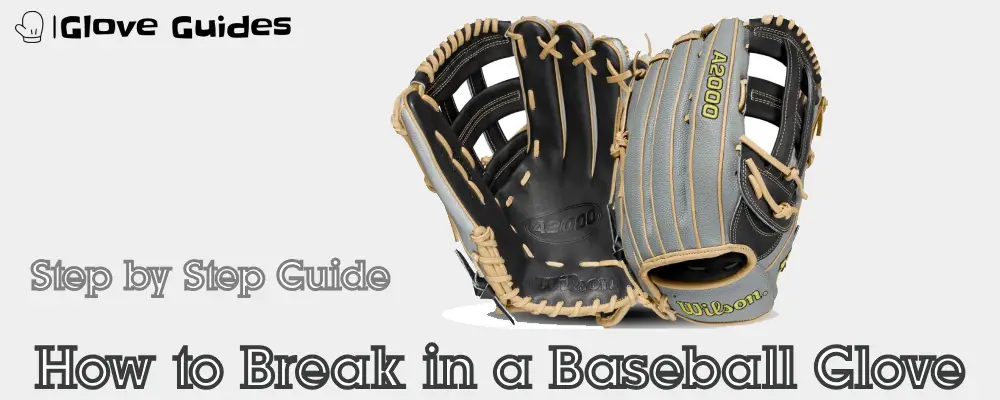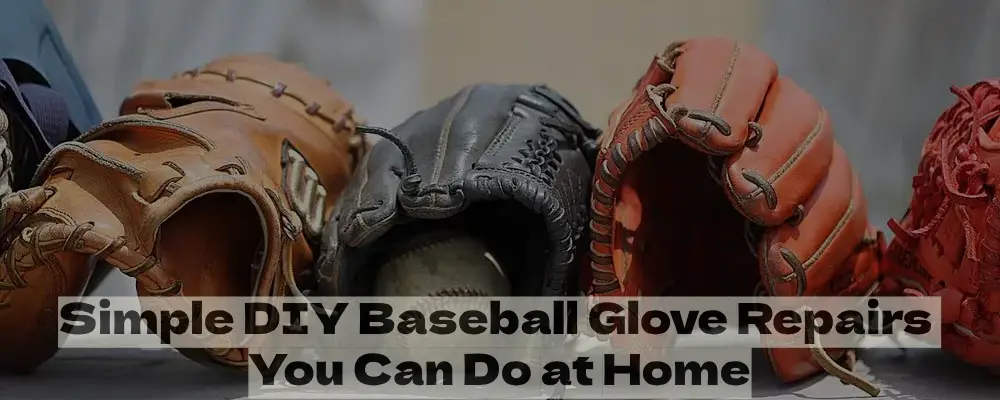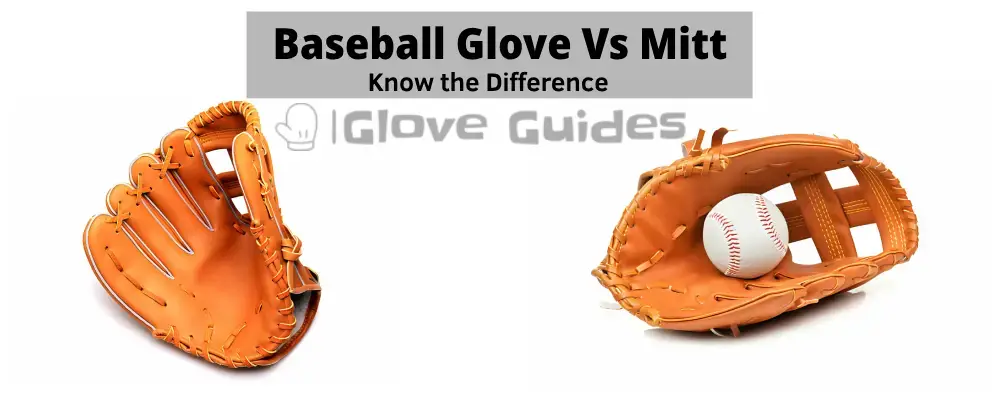
Knowing the difference between a baseball glove vs mitt is very important for a rookie. A glove has individual fingers, just like your hand, making it good for catching and throwing. While on the other hand, a mitt is like a cozy pocket, great for catching but not so much for accurate throwing.
Understanding this difference matters because it helps players choose the right gear for their game. In essence, whether you opt for a baseball glove or mitt depends on your playing style and position. So, let’s explore the basics and know the key distinction between a baseball glove and mitt.
Difference Between Baseball Mitt Vs Glove?
I. Baseball Glove
A baseball glove is a specialized piece of equipment worn by players in baseball to catch and field a thrown or hit baseball. It typically consists of a leather-covered palm and back of the hand, with individual compartments for each finger and a webbed area between the thumb and index finger. Baseball gloves come in various sizes and designs to cater to different positions and player preferences.
A. Purpose of a Baseball Glove
The primary purpose of a baseball glove is to enhance a player’s ability to:
- Catch: The glove’s design, with its webbed pocket and padding, helps absorb the impact of the ball, preventing painful stings and allowing for secure catches.
- Field: The glove extends the player’s reach and provides control over the ball, enabling them to scoop up grounders, snag line drives, and dive for difficult catches.
- Throw: The glove’s structure assists in gripping and transferring the ball for accurate and powerful throws.
B. Design and Features:
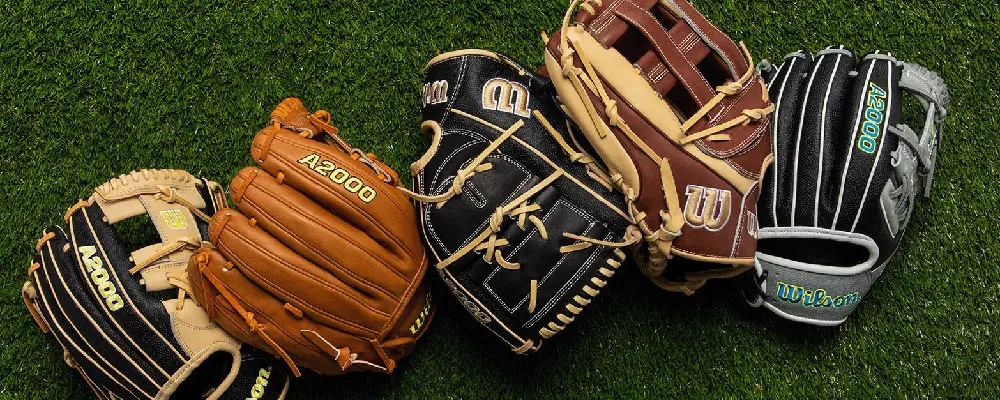
i. Fingers and Webbing:
- Fingers: The glove typically has five separate finger compartments for optimal dexterity and control. Different glove types may have variations in finger length and flexibility depending on their intended use.
- Webbing: The webbed section between the fingers is crucial for catching the ball. Common webbing types include:
- Open web: Provides a larger target area for catching fly balls and allows for quick transfers.
- Closed web: Offers a more secure pocket for holding onto the ball and is preferred for grounders and throws.
- Double-web: Combines aspects of both open and closed webs, offering both catching and throwing versatility.
ii. Padding:
- Palm and Back: The palm and back of the glove often feature padding to absorb the impact of the ball and protect the hand. Thicker padding is common in outfield gloves for high fly balls, while thinner padding in infield gloves provides greater dexterity for fielding grounders.
- Fingertips: For additional protection, some gloves have padding on the fingertips, particularly on the thumb and pinky finger, which are most vulnerable to injury.
iii. Materials Used:
- Leather: Traditionally, high-quality baseball gloves are made from full-grain leather, known for its durability, comfort, and ability to mold to the player’s hand over time.
- Synthetic materials: More affordable options use synthetic materials like PVC or nylon, which offer lighter weight and quicker break-in but may not be as durable as leather.
C. When to Use a Baseball Glove:
- Catching: Catchers wear specialized mitts with a deep pocket and no individual fingers to catch pitches and throws, providing maximum protection and control. Catchers use specialized mitts (12-13 inches) with a deep, almost funnel-shaped pocket to catch throws and block pitches. The mitt also features additional padding on the thumb and palm for protection.
- Fielding: Infielders and outfielders use different types of gloves based on their position. Infielders typically use smaller gloves with shallow pockets for quick throws, while outfielders use larger gloves with deeper pockets for catching fly balls.
- Infielders: Use gloves with shorter lengths and open webbing for quick fielding and throws. Infielders typically use smaller and lighter gloves (11-12.5 inches) with shallow pockets and open webbing for quick release throws.
- Outfielders: Use longer gloves with deeper pockets for catching fly balls and line drives. Outfielders require larger gloves (12.75-13.5 inches) with deeper pockets and closed webbing for maximum reach and ball control when catching fly balls.
- Baserunning: Although not required, some players, particularly first basemen, may wear a glove for fielding ground balls and tagging runners.
II. Baseball Mitt
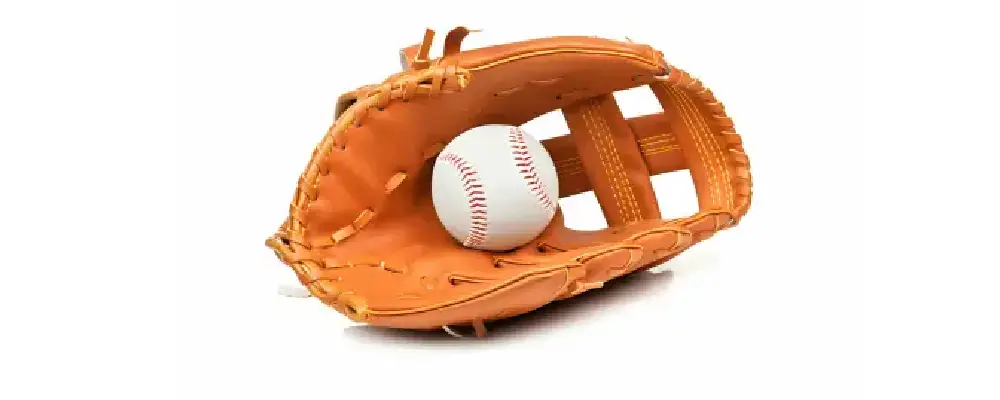
A baseball mitt is a specialized type of baseball glove designed for catching throws and blocking pitches. Unlike a conventional glove, a mitt lacks separate finger stalls and instead features a large, enclosed pocket formed by the thumb and palm sections. This enclosed design offers maximum ball control and protection for the catcher’s hand.
A. Purpose of a Baseball Mitt
The primary purpose of a baseball mitt is to:
- Catch throws: The deep pocket and enclosed design of the mitt ensure a secure catch, even for high-velocity throws.
- Block pitches: The mitt’s padding protects the catcher’s hand and wrist from the impact of fastballs and foul tips.
- Control the ball: The enclosed space allows the catcher to quickly transfer the ball from the mitt to their throwing hand for an efficient tag or throw.
B. Design and Features:
- Lack of Separated Fingers: Unlike a glove, a mitt does not have separate finger stalls. This provides increased surface area for catching throws and enhances ball control.
- Finger Guards: Catchers’ mitts may have finger guards attached to the inside for added protection of the fingers.
- Webbing: While some mitts have webbing connecting the thumb and palm, it is typically less intricate and serves more for structural support than ball control.
- Weight: Mitts are generally heavier than gloves due to their larger size and additional padding.
- Catcher’s Mitt vs. Fielder’s Mitt:
- Catcher’s Mitt: Characterized by a deeper pocket and larger size (12-13 inches) for catching high throws and protecting the hand. Thick padding is present on the thumb and palm for impact absorption.
- Larger size (12-13 inches)
- Deep, almost funnel-shaped pocket
- Thick padding on palm and thumb for impact protection
- Closed webbing or no webbing to secure caught balls
- Fielder’s Mitt: Often used at first base, featuring a smaller pocket (11-12 inches) and slightly less padding than a catcher’s mitt for increased flexibility and throwing speed.
- Smaller size (11-11.75 inches)
- Less padding
- May have open webbing for quicker transfers
C. Materials Used:
Similar to gloves, mitts are primarily made from:
- Leather: Traditionally, high-quality baseball gloves are made from full-grain leather, known for its durability, comfort, and ability to mold to the player’s hand over time.
- Synthetic materials: More affordable options use synthetic materials like PVC or nylon, which offer lighter weight and quicker break-in but may not be as durable as leather.
D. When to Use a Baseball Mitt:
- Catchers: Primarily used by catchers to catch pitches, throws, and block the strike zone.
- First Basemen: Often use a smaller fielder’s mitt for scooping ground balls and making throws to other bases.
- Situational Use: Infielders or outfielders may occasionally use a mitt for specific plays where extra protection or ball control is desired.
E. Features
- Catching Surface: The larger catching surface of a mitt allows for more forgiveness in catching throws, especially off-target ones.
- Protection: The thick padding on mitts provides excellent protection for the hand and fingers against the impact of hard throws and fastballs.
- Positioning: The mitt’s design allows for different hand positions for catching throws and blocking pitches, offering greater versatility than a glove.
III. Key Differences Between Baseball Gloves and Mitts
While both baseball gloves and mitts assist in catching and fielding the ball, several key differences distinguish them in terms of shape, design, and intended use:
A. Shape and Design:
- Gloves: Feature five separate finger stalls and a shallower pocket, offering greater dexterity and control when catching and throwing. Webbing designs vary depending on desired flexibility and pocket depth.
- Mitts: Lack individual finger stalls and have a deep, rounded pocket, maximizing catching surface area and shock absorption but sacrificing finger control. Webbing is either minimal or absent.
B. Intended Use:
- Gloves: Primarily used by infielders and outfielders who require flexibility for quick throws and covering ground. Different glove sizes and designs cater to specific positions (e.g., smaller gloves for infielders, larger gloves for outfielders).
- Mitts: Primarily used by catchers and first baseman who need protection from fast throws and hard-hit balls, prioritizing catching over throwing. Catcher’s mitts offer additional padding and a closed pocket for secure catches, while fielder’s mitts offer less padding and may have open webbing for quicker transfers.
C. Specialized Roles:
- Gloves: While primarily position-specific, some players may use a glove outside its typical role (e.g., an outfielder using a smaller glove for infield practice).
- Mitts: Have specialized designs for specific roles:
- Catcher’s mitt: Deep pocket, thick padding, and closed webbing for catching pitches and throws.
- Fielder’s mitt: Smaller size and less padding for scooping ground balls and making quick throws.
IV. Choosing the Right Baseball Glove or Mitt:
Whether you’re a seasoned veteran or a brand new player, finding the perfect fit is crucial for performance and comfort. To help you make an informed decision, let’s explore key considerations, personal preferences, and position-specific recommendations:
A. Considerations for Players:
- Age and Skill Level: Beginner players often start with smaller, lighter gloves for easier control, while experienced players may prefer larger, more specialized options.
- Position: Each position demands specific features in a glove/mitt. Infielders require agility, outfielders need reach, and catchers prioritize protection.
- Budget: High-quality leather gloves come at a premium, while synthetic options offer affordable alternatives.
- Throwing Hand: Choose a left-handed or right-handed glove/mitt to ensure a natural throwing motion.
- Webbing Style: Open webbing facilitates quick throws, while closed webbing conceals the grip from batters.
B. Personal Preferences:
- Feel: The glove/mitt should feel comfortable and secure on your hand, allowing for natural movement.
- Break-in Period: Leather gloves require break-in for optimal flexibility, while synthetic options are ready to play instantly.
- Durability: High-quality materials like full-grain leather offer superior durability compared to synthetic options.
- Style: Choose a glove/mitt that matches your personal preferences for color, brand, or customization options.
C. Position-Specific Recommendations:
- Infielders:
- Size: 11″-12.5″
- Webbing: Open or closed, depending on preference
- Features: Lightweight, flexible, shallow pocket for quick throws
- Outfielders:
- Size: 12.75″-13.5″
- Webbing: Open or closed, depending on preference
- Features: Deeper pocket for fly balls, longer length for reach
- Catchers:
- Mitt: 12″-13″
- Features: Deep, funnel-shaped pocket, thick padding, closed webbing
- First Basemen:
- Mitt: 11″-11.75″
- Features: Less padding than catcher’s mitt, open webbing for quicker transfers
Expert Tips:
- Try on various gloves/mitts before purchasing to find the best fit and feel.
- Seek advice from experienced players or coaches for recommendations.
- Invest in proper care and maintenance to extend the life of your glove/mitt.
Don’t forget, choosing the right baseball glove or mitt is a personal journey. By considering your needs, preferences, and position, you can find the perfect equipment to elevate your game and maximize your enjoyment on the field!
V. Maintaining and Caring for Your Baseball Glove or Mitt
Proper care and maintenance are crucial to extend the life of your baseball glove or mitt and ensure optimal performance. Here’s a breakdown of essential cleaning and storage tips:
A. Cleaning:
- Frequency: Clean your glove/mitt after every game or practice session, especially if it gets dirty or wet.
- Materials: Use a soft brush or damp cloth (avoid soaking) for leather gloves/mitts. For synthetic options, check the manufacturer’s cleaning instructions.
- Soap: Avoid harsh soaps or detergents. Opt for a mild soap solution or specialized leather cleaner.
- Drying: Let your glove/mitt air dry naturally in a cool, shaded place. Avoid direct sunlight or heat sources, which can crack the leather.
- Conditioning: After cleaning and drying, apply a leather conditioner (specifically formulated for baseball gloves) to keep the leather supple and prevent cracking. Follow the manufacturer’s instructions for application.
B. Storage:
- Shape: Store your glove/mitt with a ball nestled in the pocket to maintain its shape.
- Location: Choose a cool, dry place away from direct sunlight, heat sources, and moisture. Avoid garages or basements, which can be prone to humidity and mold.
- Hanging: Hanging your glove/mitt by the fingers allows air circulation and prevents moisture buildup.
- Stuffing: Don’t stuff your glove/mitt with paper or other materials, as this can distort its shape.
- Traveling: When traveling with your glove/mitt, pack it in a well-ventilated bag to prevent moisture buildup and odor.
Expert Tips:
- Avoid storing your glove/mitt in your car, especially during hot weather, as the heat can damage the leather.
- If your glove/mitt gets soaked in rain, dry it as quickly as possible and apply a leather conditioner afterwards.
- Don’t use oil or grease on your glove/mitt, as these can attract dirt and soften the leather.
- Regular cleaning and conditioning will not only prolong the life of your glove/mitt but also enhance its performance and feel.
By following these simple cleaning and storage tips, you can ensure your baseball glove or mitt remains your trusted companion on the field for many seasons to come!
Final Words
Depending on your position, you can use a glove or a baseball mitt. Playstyle or taste usually has no bearing on it. According to the rules, all defensive players must wear baseball gloves; only the catcher and first baseman are permitted to use mitts.
You have some discretion in terms of what kind of mitt or glove you want to buy, but that’s about it. Therefore, if you are a catcher, you will need to get a high-end catcher’s mitt in order to play with it; wearing infielders’ gloves won’t do.
FAQs
Is a Baseball Glove Called a Mitt?
Not all baseball gloves are called mitts. Mitts specifically have no separate fingers, while most gloves do. Catchers and first basemen usually use mitts, while other positions use gloves with individual fingers for better dexterity. So, a mitt is a type of baseball glove, but not all gloves are mitts.
What is a mitt used for?
A mitt shields the hand. Ever since baseball was first played in the 19th century, each player on a team has used a mitt. Prior to that, players would either use their bare hands to gently cushion their catching hand or they would make makeshift gloves by cutting off the fingers. The mitts of today are robust and wide.
What is the purpose of a mitt?
On ski slopes, mittens are a typical appearance since they offer additional warmth and protection from injuries. They are also advised as a component of apparel for extremely cold temperatures. In the kitchen, oven mitts are used to shield hands from hot surfaces.
